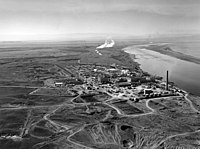
Photo from wikipedia
Abstract Conventional biological nutrient removal techniques often have disadvantages like low removal efficiencies, requirement of large footprint, and excess sludge production. Ever increasing stringent discharge standards demand for alternative technologies.… Click to show full abstract
Abstract Conventional biological nutrient removal techniques often have disadvantages like low removal efficiencies, requirement of large footprint, and excess sludge production. Ever increasing stringent discharge standards demand for alternative technologies. In this context aerobic granular sludge (AGS) has evolved as a promising technology for complete nutrient removal. However, degradation of structural integrity of aerobic granules in long run is a prime concern of this technology. This work attempts to develop stable aerobic granules in an automated sequential batch airlift reactor (SBAR) for simultaneous C, N, and P removals under alternating aerobic and anoxic conditions. The reactor was operated at high sludge retention time (SRT). Combined operating strategies of varying dissolved oxygen (DO) concentration and feed cycle times were followed to optimize the conditions for effective granulation and subsequent removal efficiencies. Profiles of extracellular polymeric substances (EPS) and sludge volume index (SVI) were monitored. Optimum removal efficiencies of NH4+-N (92.7%), TN (90.6%), COD (90.1%), and PO43--P (83.2%), and granules of size 1.3 to 8 mm were achieved in phase IV at operational DO of 1 to 2 mg/L, and feeding intervals of 15 h and 9 h. NH4+-N (R2 = 0.97, k = 0.5093/h) and PO43--P (R2 = 0.95, k = 0.2574/h) removals were fitted well with first order kinetic model and that of COD (R2 = 0.97, k = 0.0032 L/mg/h) followed second order kinetics. This process is economical as effective biological nutrient and organics removal occurs in a single reactor without requirement of alkalinity supply, and negligible excess sludge production. The process requires small foot print and applicable for decentralized wastewater management in University campuses/tourist resorts/apartment complexes.
Journal Title: Journal of environmental chemical engineering
Year Published: 2021
Link to full text (if available)
Share on Social Media: Sign Up to like & get
recommendations!